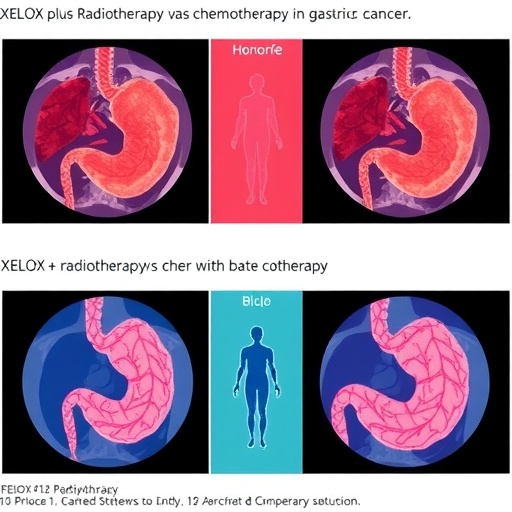
In a groundbreaking study published in BMC Cancer, researchers have unveiled compelling evidence favoring the use of a combined neoadjuvant chemoradiotherapy approach over chemotherapy alone for patients suffering from locally advanced gastric cancer. This pivotal research explores the comparative effectiveness and safety profiles of the XELOX chemotherapy regimen—comprising oxaliplatin and capecitabine—when administered with neoadjuvant radiotherapy, contrasting it with the standard neoadjuvant chemotherapy protocol.
Gastric cancer, notoriously difficult to treat due to its typically late diagnosis and aggressive nature, remains a significant global health challenge. The imperative to optimize treatment regimens to enhance tumor shrinkage prior to surgery, improve surgical outcomes, and ultimately elevate patient survival rates has driven oncologists and researchers alike to investigate innovative therapeutic combinations. This study represents a salient stride towards that goal, meticulously assessing clinical data from 409 patients who underwent radical gastrectomy with D2 lymph node dissection between 2019 and 2020.
The investigators employed robust statistical methodologies, including inverse probability weighting (IPW), to meticulously adjust for confounders and balance baseline characteristics between patients receiving XELOX combined with neoadjuvant radiotherapy (CRT group) versus those who underwent neoadjuvant chemotherapy alone (NACT group). Such rigorous analytical techniques bolster the validity of the comparative outcomes reported, lending substantive weight to the findings.
One of the most striking results centers on the pathological complete response rates observed in the two cohorts. Patients treated with the CRT regimen exhibited substantially higher rates of complete tumor eradication on pathological examination (15.8%) compared to their NACT counterparts (4.7%). This pronounced difference underscores the enhanced tumoricidal efficacy achieved through the synergistic effects of combining radiotherapy with chemotherapy prior to surgical intervention.
Further reinforcing the advantage of chemoradiotherapy, the study found a significantly higher negative conversion rate of carcinoembryonic antigen (CEA)—a critical tumor biomarker—in the CRT group (38.1%) compared to NACT patients (11.8%). This biomarker clearance potentially signals superior tumor control and may correlate with improved long-term outcomes, opening new vistas for prognostic stratification.
Concomitantly, tumor regression grading (TRG), a histopathological measure of cancer response to treatment, was markedly more favorable among patients receiving CRT. The proportion achieving TRG 0–1, indicative of minimal residual tumor cells, was over double in the CRT group (60.3% versus 24.3%), emphasizing the profound impact of integrating radiotherapy into the neoadjuvant treatment landscape.
Notably, the CRT cohort also enjoyed significantly improved downstaging of the tumor, with postoperative pathological stages ypT0 and T1 comprising 35.5% of patients, nearly tripling the rates seen with chemotherapy alone. This level of tumor downstaging can translate to more effective surgical resection and potentially better postoperative prognoses.
A curious yet clinically relevant finding emerged concerning lymph node dissection and status. Despite a lower average number of lymph nodes dissected in the CRT group (17 versus 24), the rate of pathological node negativity (ypN0) was significantly higher at 60.3%, compared to 39.8% in the NACT group. This suggests that CRT may more effectively sterilize nodal metastases, potentially lowering the burden of systemic disease.
Surgical radicality, a cornerstone for curative intent in gastric cancer surgery, was impressively achieved in both groups, with CRT enabling a 100% R0 resection rate versus 96.5% in the chemotherapy-alone cohort. Achieving R0 resection, defined as complete removal of all macroscopically and microscopically detectable tumor tissue, is critical for optimizing long-term survival in gastric cancer patients.
Importantly, despite the intensified treatment regimen, patient safety profiles between the two groups were comparable. The study meticulously evaluated perioperative complications and adverse events such as bone marrow suppression, gastrointestinal toxicities including nausea, vomiting, esophagitis, and diarrhea, finding no significant differences. This observation assuages concerns regarding the potential escalation of treatment-related morbidity when combining radiotherapy with chemotherapy.
Hospitalization times were also similar across both cohorts, suggesting that adding radiotherapy did not impose additional burdens in terms of recovery or healthcare resource utilization. The comparable safety and recovery metrics highlight that neoadjuvant chemoradiotherapy can be safely integrated into clinical practice without compromising patient quality of care or imposing undue risks.
From an oncological outcome perspective, the CRT group displayed superior disease-free survival, a vital metric reflecting the period wherein patients remain free from cancer recurrence post-treatment. However, overall survival differences did not reach statistical significance within the follow-up time frame, suggesting that longer-term studies may be necessary to unravel whether the initial disease control benefits translate into extended survival advantages.
The meticulous correlation analyses conducted between clinical variables and tumor biomarkers further enrich the understanding of prognostic factors in gastric cancer. Identifying reliable biomarkers capable of predicting response to neoadjuvant therapies remains a critical research frontier. The study’s findings advance this pursuit by delineating significant associations that could inform personalized treatment strategies in the future.
Collectively, these findings herald a paradigm shift in the management of locally advanced gastric cancer, underscoring the potential of integrating radiotherapy with the XELOX chemotherapy backbone to achieve deeper tumor regression and improved local control without compromising safety. Such evidence advocates for broader adoption of chemoradiotherapy approaches and paves the way for prospective randomized trials to consolidate these encouraging observational data.
The research team’s retrospective analysis, encompassing a substantial patient sample, provides a granular view of treatment dynamics in a real-world setting, balancing the rigor of controlled studies with pragmatic clinical insight. This approach enables a nuanced appreciation of treatment tolerability and efficacy that resonates with practicing oncologists and surgeons.
In sum, the study injects renewed optimism into the quest for enhancing neoadjuvant treatment paradigms in gastric cancer. By harnessing the complementary mechanisms of chemotherapy and radiotherapy, the combined XELOX plus neoadjuvant radiotherapy strategy emerges as a potent contender capable of amplifying tumor downstaging, bolstering pathological responses, and facilitating optimal surgical outcomes.
As the oncology community strives to refine multimodal treatment regimens, this landmark investigation lays a robust foundation for evolving guidelines and clinical decision-making. Future research endeavors will no doubt build upon these insights, potentially incorporating molecular and immunological profiling to further personalize therapy and maximize patient benefit.
Meanwhile, patients diagnosed with locally advanced gastric cancer may look forward to emerging treatment options that strategically amalgamate systemic and local therapies to surmount this formidable disease. Such advances echo the broader commitment within cancer research to transcend conventional boundaries and usher in an era of precision medicine.
The findings reported by Bu, Wang, Wang, and colleagues illuminate a promising therapeutic avenue and reaffirm the critical importance of integrating multi-disciplinary approaches to achieve superior cancer control. This harmonization of chemotherapy and radiotherapy stands poised to redefine standards of care and improve the clinical trajectory for countless individuals afflicted with gastric malignancies.
Subject of Research: Efficacy and safety comparison of XELOX chemotherapy combined with neoadjuvant radiotherapy versus neoadjuvant chemotherapy alone in locally advanced gastric cancer.
Article Title: Efficacy and safety of XELOX combined with neoadjuvant radiotherapy versus neoadjuvant chemotherapy in locally advanced gastric cancer.
Article References:
Bu, S., Wang, S., Wang, T. et al. Efficacy and safety of XELOX combined with neoadjuvant radiotherapy versus neoadjuvant chemotherapy in locally advanced gastric cancer. BMC Cancer 25, 731 (2025). https://doi.org/10.1186/s12885-025-14103-1
Image Credits: Scienmag.com
DOI: https://doi.org/10.1186/s12885-025-14103-1
Tags: clinical outcomes in gastric cancercomparative effectiveness researchD2 lymph node dissectiongastric cancer treatmentinnovative therapeutic combinationsneoadjuvant chemoradiotherapyoptimizing treatment regimens for gastric cancerpatient survival rates in cancerradical gastrectomy proceduressafety profiles of cancer treatmentsstatistical methodologies in clinical researchXELOX chemotherapy regimen





